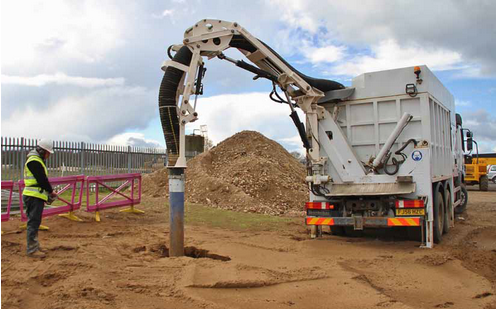In the ever-evolving construction and utility industries, the demand for effective and environmentally-friendly excavation methods is at an all-time high. Traditional digging techniques often lead to significant disruptions, including damage to underground utilities and environmental degradation. Enter vacuum excavation, a revolutionary method that is quickly becoming the new standard in non-destructive digging. This article explores the benefits, applications, and efficiency of vacuum excavation, demonstrating why it is an essential tool in modern construction practices.

What is Vacuum Excavation?
Vacuum excavation is a non-destructive digging technique that utilizes a high-powered vacuum system to remove soil and debris from an excavation site. Unlike conventional methods, which involve digging with heavy machinery, vacuum excavation allows for precise and controlled removal of material. This technique involves two key components: a vacuum truck equipped with a powerful suction system and a water jetting system that loosens the soil before it is extracted.
The process begins by using water or air to break up the soil, making it easier to remove. The vacuum truck then sucks up the loosened material, transporting it to a containment tank for proper disposal. This method is particularly effective in urban areas where underground utilities are prevalent, as it minimizes the risk of damaging existing infrastructure.
Benefits of Vacuum Excavation
1. Safety First
One of the most critical advantages of vacuum excavation is its focus on safety. Traditional digging methods can pose numerous risks, including cave-ins, equipment accidents, and damage to underground utilities. Vacuum excavation significantly reduces these hazards by allowing operators to excavate with greater precision. The non-destructive nature of this technique means that workers can operate with confidence, reducing the likelihood of accidents and injuries on site.
2. Environmental Protection
Vacuum excavation is also an environmentally responsible choice. Conventional excavation often leads to soil displacement, erosion, and potential contamination of local water sources. In contrast, vacuum excavation minimizes soil disturbance, preserving the natural landscape and protecting the surrounding ecosystem. By containing excavated materials and preventing runoff, this method helps maintain local water quality and promotes biodiversity.
3. Cost-Effectiveness
While investing in vacuum excavation equipment may require an upfront cost, the long-term savings can be substantial. The efficiency of this method leads to reduced labor hours and minimizes the need for extensive site restoration efforts that often follow traditional digging. Additionally, the prevention of utility strikes and associated repair costs can save construction companies significant amounts of money over time.
4. Precision and Efficiency
Vacuum excavation allows for greater precision compared to traditional methods. This level of accuracy is particularly important when working around existing utilities, as it reduces the risk of accidental damage. The quick and efficient nature of vacuum excavation means that projects can progress without unnecessary delays, ultimately leading to shorter project timelines and improved productivity.
Applications of Vacuum Excavation
1. Utility Maintenance and Installation
Vacuum excavation is particularly beneficial for utility companies engaged in the maintenance and installation of underground services. This method allows for safe excavation around gas, water, electricity, and telecommunications lines, minimizing the risk of damaging critical infrastructure. Utility companies can perform necessary maintenance tasks without disrupting service to customers.
2. Construction Projects
In construction, vacuum excavation provides a non-invasive solution for site preparation and foundation work. By using this method, contractors can efficiently excavate while protecting the surrounding environment and existing structures. Vacuum excavation is also useful for trenching and potholing, where precise digging is essential.
3. Environmental Remediation
Vacuum excavation plays a vital role in environmental remediation efforts. When dealing with contaminated soil, this method allows for the careful removal of hazardous materials without spreading pollutants. This targeted approach ensures that remediation activities are effective and compliant with environmental regulations.
4. Road and Pavement Repair
Vacuum excavation is increasingly being used in road and pavement repair projects. By removing asphalt and soil without damaging the underlying infrastructure, contractors can efficiently conduct repairs and upgrades. This technique allows for minimal disruption to traffic and surrounding areas, making it an ideal choice for urban environments.
The Future of Vacuum Excavation
As the construction industry continues to prioritize sustainability and safety, vacuum excavation is poised to become the standard for non-destructive digging. The increasing awareness of environmental issues and the need for efficient utility management drive the demand for this innovative technique. As technology advances, vacuum excavation equipment is expected to become even more sophisticated, further enhancing its effectiveness and efficiency.
Conclusion
In conclusion, vacuum excavation represents a significant advancement in non-destructive digging practices. Its benefits—ranging from enhanced safety and environmental protection to cost-effectiveness and precision—make it an essential tool in modern construction and utility management. As the industry moves towards more sustainable practices, vacuum excavation is set to become the new standard.
For those in need of expert vacuum excavation services, partnering with experienced providers is crucial. Utility Site Solutions offers specialized expertise in vacuum excavation, ensuring that projects are executed safely and efficiently. By embracing this innovative technique, businesses can contribute to a cleaner, safer, and more sustainable future in construction.
